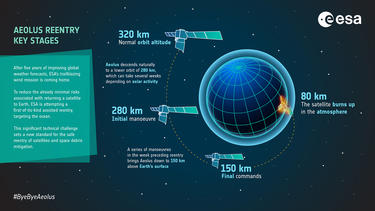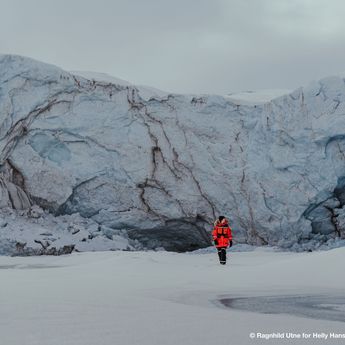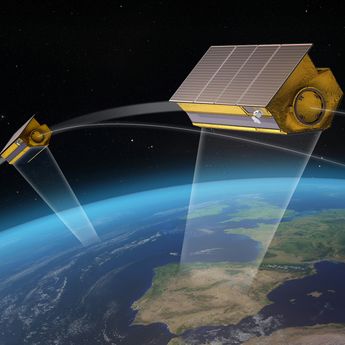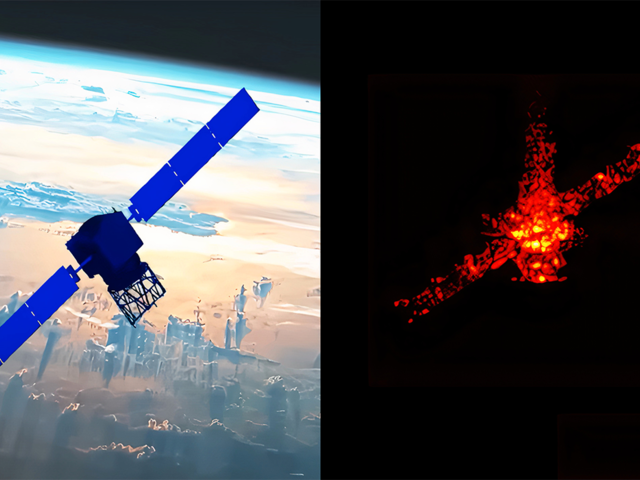On 28 July 2023 Aeolus, a meteorological satellite built by Airbus and operated by the European Space Agency (ESA), bid its farewell, burning up as it reentered the Earth’s atmosphere. Well-known for its pioneering monitoring of wind conditions on a global scale, helping climatologists improve weather forecasts and climate models over the past five years, Aeolus will also enter the history books as the first assisted satellite reentry, initiated by Airbus.
The idea began to take shape in 2021 among the Airbus teams overseeing Aeolus operations. Defining and putting in place a re-entry procedure that had never been tried before was a challenge, and one that ESA accepted and implemented.
A challenging safe reentry requiring innovation
To make the shift from uncontrolled to assisted reentry, the Airbus team had to factor in multiple limitations linked to the satellite’s design and mission.
For several years, the Inter-Agency Space Debris Coordination Committee (IADC) has recommended designing spacecraft in such a way that they are as demisable* as possible, to minimise the number of remaining fragments that might cause damage on the ground. “As the design was decided before current regulation came into effect, it was not possible to minimise the number and size of remaining fragments that might cause damage on the ground as the spacecraft was already in orbit,” explains Airbus space debris focal point Frédéric Payot.
Defining an alternative trajectory
Developed at the beginning of the 2000s with a low-risk but nevertheless uncontrolled reentry plan, Aeolus would have fallen naturally back to Earth within a few months. However, with no possibility to steer the satellite to a selected area, it could have landed anywhere.
The initial strategy assessed the possibility to perform controlled reentry for Aeolus to confine the debris footprint on the ground. Unfortunately, the thrusters could not produce enough force to target a reentry in the South Pacific Ocean Uninhabited Area (SPOUA), designated by the UN for deorbited space systems splashdown.
“We had to come up with an alternative,” says Payot. “We needed to identify a strategy in between controlled and uncontrolled reentry, taking maximum benefit from satellite capabilities. The polar orbit of Aeolus offers the possibility to target some ground tracks with little landmass and very few inhabitants. In particular, a corridor in the Atlantic Ocean was selected to guarantee safe entry into the atmosphere”.

Essential engineering skills
To effectively manage Aeolus’ return to Earth, Airbus’ UK and Toulouse teams made use of specific engineering skills. “Our flight dynamics experts calculated the orbital trajectory of the spacecraft down to low altitude and in an atmosphere with significant density,” Payot explains. “On top of that, we had to ensure the satellite was still able to fly at very low altitude (150 km), while keeping all the forces acting on it in check.”
Atmospheric modelling was key to estimating drag and its impact on Aeolus’ trajectory when controlling the satellite’s altitude and orbit. “We made trajectory predictions based on the natural drift of the satellite, and we had to take the Sun into account, too,” Payot says. Solar activity has a huge impact on the Earth’s upper atmosphere. Indeed, drag increases with solar activity, which impacts altitude and reentry date.
“Preparing the reentry well in advance was paramount,” Payot concludes. “We couldn’t have put this cutting-edge strategy in place in six months; it took nearly two years to prepare for these end of life operations. Defining a new targeted entry area and operating a satellite outside of its original flight domain was a huge challenge requiring a lot of preparation and anticipation.”
Reducing space debris as a target
According to ESA’s Space Environment Report, in 2023 more than 30,000 trackable objects (>10 cm) are located in Low Earth Orbit (LEO) at an altitude of less than 2,000 km. One way to limit debris pollution in space is to remove spacecraft from their orbit.
Aeolus’ successful reentry not only celebrates the ingenuity and knowledge of Airbus’ engineers; it also highlights the importance of innovation to find solutions to mitigate space debris. Airbus renewed its commitment with ESA with the Zero Debris Charter in June 2023, a further step towards achieving global leadership in space debris mitigation and remediation.
* The Design for Demise approach proposes design alternatives which improve the disintegration and ablation of the spacecraft during the reentry in the atmosphere (e.g change the material or the shape of the spacecraft.)
Latest News
Continue Reading

Web Story Space
Glaciers in danger: satellites underscore extent of climate emergency
Satellites help scientists like Heïdi Sevestre track rapid glacier melt. Discover the impact of their changes on Earth’s life & ecosystems.
Press Release Space
Airbus awarded Hisdesat contract to build PAZ-2 satellites reinforcing Spain's…
Press Release Company
Airbus Defence and Space implements new organisation to shape division’s future…

Web Story Space
Why you should care about space weather

Web Story Space
Biomass, a satellite to look inside the world’s forests like never before
